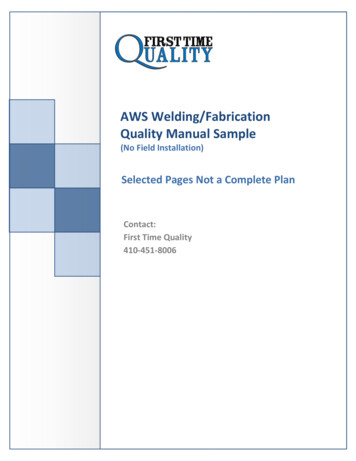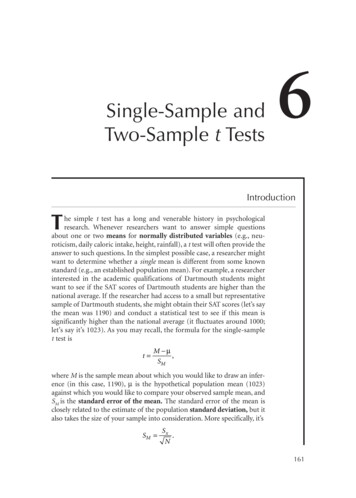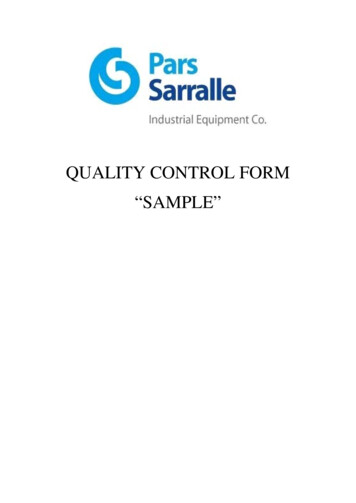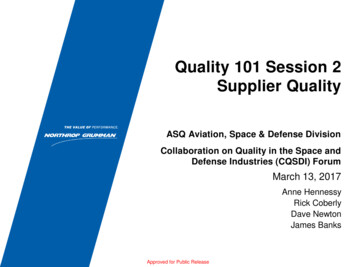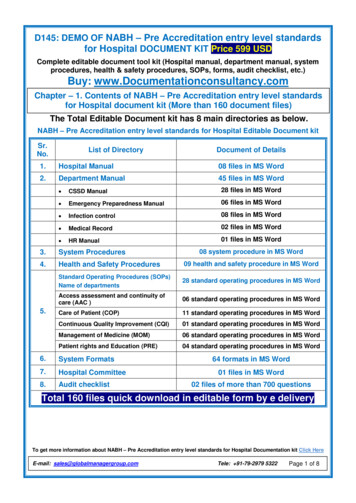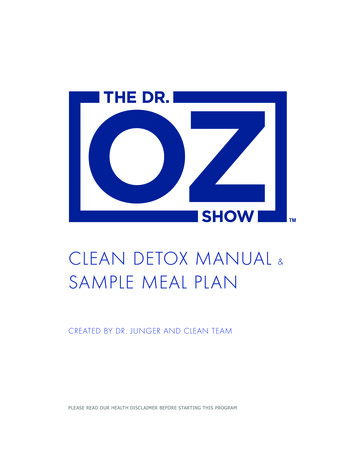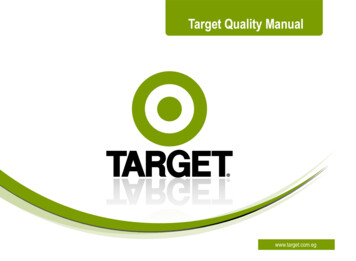
Transcription
ITTC-SampleQuality Manual(based on the International Standard ISO 9001:2000)CompanyCopy No.Subject to revisionyesnoThe Quality Manual is property of company’s nameConfidential; no copying or distributing to third parties without authorisationCompany
To the Proceedings of the QSG to the 23rd ITTCITTC Sample Quality ManualIn order to support the memberorganisations of the ITTC in introducing aquality control system according to ISO9000:2000 or in changing from standard ISO9000:1994 to ISO 9000:2000, the QSG of the23rd ITTC assembled a updated Sample QualityManual. This Sample Quality Manual providesguidance for quality management and modelsfor quality assurance.Compared to ISO 9001/9002:1994 thestructure of ISO 9001:2000 was changedcompletely, including the name from QualitySystem was changed to Quality ManagementSystem. The requirements seem to be moregeneral and provide improved flexibility. ISO9001:2000 is aimed equally at manufacturingas well as service organizations, with a strongfocus on customer satisfaction. The majorreasons for the year 2000 revisions of thestandard include emphasizing the need tomeasure customer satisfaction, meeting theneed for more user-friendly entsystemrequirementsandguidelines, and incorporating generic qualitymanagement principles into organizations.1Scope2Normative reference3Terms and definitions4Quality management system5Management responsibility6Resource management7Product realization8Measurement, analysis and improvementThe 8 sections of the Quality Manual obligatory by the standard ISO 9000:2000The QSG hopes by submitting this sample tosimplify and support the implementation ofquality control systems or the adaptation to theupdated standard ISO 9000:2000 in thecommunity of the ITTC.
Model of a process-based quality management system
ITTC-Sample QualityManualPage 1 of 1ForewordFOREWORDThis Sample Quality Manual providesguidance for quality management and modelsfor quality assurance. Because needs oforganizations vary, it is not the purpose of thisSample Quality Manual to enforce uniformityof quality systems. The design andimplementation of a quality managementsystem necessarily is influenced by theparticular organisation’s objectives, products,processes and individual practices.Prepared, verified and approvedQuality Systems Groupof the 23rd ITTCDate: 09/2002The selection of appropriate elements andthe extent to which these elements are adoptedand applied by an organization depends uponseveral factors such as market being served,nature of product, production processes,clientele, and customer needs.References in this Sample Quality Manualto a ‘product’ should be interpreted also asapplicable to the generic product categories ofservice (such as model tests, calculations, etc.),hardware, software or process materials.
CompanyITTC-Sample QualityManualSection 0Page 1 of 1Effective tsEffective 20111Scope09/2002013normative reference09/20020123Glossary of terms09/20020154Quality management system09/20020185Management responsibility09/20020196Resource management09/20020147Product realization09/200201168Measurement, analysis and improvement09/20020182Application and ITTC–Recommended Procedures asPreparedVerifiedApprovedNameDateNameDateNameDate
CompanyITTC-Sample QualityManualSection 1Page 1 of 2Effective Date09/2002ScopeRevision011. SCOPECompared to ISO 9001/9002:1994 thestructure of ISO 9001:2000 was changedcompletely, including the name from QualitySystem was changed to Quality ManagementSystem. The requirements seem to be moregeneral and provide improved flexibility. ISO9001:2000 is aimed equally at manufacturingas well as service organizations, with a strongfocus on customer satisfaction. The majorreasons for the year 2000 revisions of thestandard include emphasizing the need tomeasure customer satisfaction, meeting theneed for more user-friendly documents,assuring consistency between qualitymanagement system requirements andguidelines, and incorporating generic qualitymanagement principles into organizations.A quality-management system bringstogether people, processes, methods and toolswith the aim of constantly improving both thesystem and the company's products. All ofthese efforts are geared to the customer andcustomer satisfaction.This Sample Quality Manual of ITTC, onthe basis of the Standard EN ISO 9001:2000,provide guidance on quality management andquality system elements. The quality systemelements are suitable for use in thedevelopment and implementation of acomprehensive and effective in-house qualitysystem, with a view to ensuring customersatisfaction.A primary concern of any organisationshould be the quality of its products andservices. In order to be successful, anorganisation should offer products andservices that: Meet a well defined need, use, orpurpose Satisfy customer’s expectations Comply with applicable standards andspecifications Comply with requirements of society Have an awareness of environmentalneeds Are made available at competitiveprices Are provided economicallyIn order to meet its objectives, theorganisation should ensure that the technical,administrative and human factors affectingthe quality of its products or services will beunder control, whether hardware, software orprocessed materials. All such control shouldbe oriented towards the reduction, eliminationand, most importantly, prevention of qualitynonconformities.A quality system should be developed andimplementedforthepurposeofaccomplishing the objectives set out in theorganisation’s quality policy.Each element (or requirement) in a qualitysystem varies in importance from one type ofPreparedVerifiedApprovedNameDateNameDateNameDate
CompanyITTC-Sample QualityManualScopeactivity to another and from one product toanother. In order to achieve maximumeffectiveness and to satisfy customerexpectations, it is essential that the qualitysystem be appropriate to the type of activityand to the product being offered.A quality management system has twointerrelated aspects:1. The customer’s needs and expectationsFor the customer, there is a need forconfidence in the ability of theorganisation to deliver the desiredquality as well as the consistentmaintenance of that quality.2. The organisation’s needs and interests.For the organisation, there is abusiness need to attain and to maintainthe desired quality at an optimum cost;Section 1Page 2 of 2Effective Date09/2002Revision01the fulfilment of this aspect is relatedto the planned and efficient utilizationof the technological, human andmaterial resources available to theorganisation.Benefit, cost and risk considerations havegreat importance for both organisation andcustomer.An effective quality management systemshould be designed to satisfy customer needsand expectations while serving to protect theorganisation’s interests. A well-structuredquality management system is a valuablemanagement resource in the optimisation andcontrol of quality in relation to benefit, costand risk considerations.
ITTC-Sample QualityManualCompanySection 2Page 1 of 2Application and ITTC–Recommended Procedures Effective Date Revision09/200201as Normative Reference2.1 QUALITYIn supplying products or services there arethree fundamental parameters which determinetheir saleability. They are price, quality, anddelivery time. Customers require products andservices of a given quality to be delivered or beavailable in a given time and to be of a pricewhich reflects value for money. Anorganization will survive only if it creates andretains satisfied customers and this will only beachieved if it offers products or services whichrespond to customers’ needs and expectations.While price is a function of cost, profit margin,and market forces, and delivery a function ofthe organization’s efficiency and effectiveness,quality is determined by the extent to which aproduct or service successfully serves thepurposes of the user during usage. Price anddelivery are both transient features whereas theimpact of quality is sustained long after theattraction or the pain of price and delivery hassubsided.2.2 WHAT IS ISO 9001The standard ISO 9001:2000 has the containsspecificrequirements and recommendations for thedevelopment of a quality management system.ISO 9001 is not a product standard. Therequirements and recommendations apply tothe organizations that supply the product orservice, and hence affect the manner in whichthe products and services are designed,manufactured, installed, delivered etc. They arestandards which apply to the management ofthe organization and only the management canand should decide how it will respond to theserequirements and recommendations.2.3 APPLICATION AND EFrom the very beginning the ITTC aimed torecommend procedures for general use incarrying out physical model experiments.Quality Management Systems in accordance toISO 9001 only deal with the management ofquality management and not with qualityrequirements. To fix the quality standards forproducts or services is the responsibility ofeach individual company. Thus ITTC for yearshas been acting beyond the scope of qualitymanagement systems as the recommendationsrefer to the quality of the product or serviceitself. As quality management systems becomemore and more obligatory for model basins itwas decided to assemble a manual called“ITTC–Recommended Procedures” containingall recommendations which have been adoptedby the ITTC up to te
CompanyITTC-Sample QualityManualSection 2Page 2 of 2Application and ITTC–Recommended Procedures Effective Date Revision09/200201as Normative ReferenceITTCQUALITY SYSTEMS MANUALITTC-SampleQuality ManualITTC-Recommended ProceduresThe scope of the ITTC–RecommendedProcedures is to give the member organizationsthe possibility to make reference in the work.instructions of their own Quality Manual to theITTC–Recommended Procedures.
ITTC-Sample QualityManualCompanySection 3Page 1 of 5Effective Date09/2002Glossary of TermsRevision013 GLOSSARY OF TERMSThis glossary has been prepared to provide a definition of some of the terms used in the field ofquality assurance.AssuranceEvidence (verbal or written) that gives confidence that something willor will not happen or has not happened.AuditSystematic, independent and documented process for obtaining auditevidence and evaluating it objectively to determine the extend towhich audit criteria are fulfilled. The comparison of the practices andsystems with the precisely defined methods, procedures andinstructions it has stated it works to. An examination of records oractivities to verify their accuracy, usually by someone other then theperson responsible for them.BenchmarkingA technique for measuring an organisation’s products, services, andoperations against those of its competitors, resulting in search for bestpractice that will lead to superior performance.CalibrationAll the operations are engaged in for the purpose of determining thevalues of errors of a measuring instrument and, if necessary, ofdetermining other measurement properties.CapabilityAbility of an organization, system or process to realize a product thatwill fulfil the requirements for that product.CertificationThe authoritative act of documenting compliance with agreedrequirements.CompetenceDemonstrated ability to apply knowledge and skills.Computer softwareSoftware covers all instructions and data which are input to acomputer to cause it to function in any mode; it includes operatingsystems, compilers and test routines as well as applications programs.The definition embraces the documents used to define and describethe program (including flowcharts, network diagrams and eDate
CompanyITTC-Sample QualityManualGlossary of TermsSection 3Page 2 of 5Effective Date09/2002Revision01listings) and also covers any associated specifications, inspectionplans, inspection data, inspection results and other instructions.ContractAn agreement formally executed by both customer and organisation(enforceable by law) which requires performance of services ordelivery of products at a cost to the customer in accordance withstated terms and conditions.ConformityThe fulfilment of a specified requirement by quality characteristic ofan item or service.Corrective actionAction to eliminate the cause of a detected nonconformity or otherundesirable situation.CustomerOrganisation or person that receives a product.Customer satisfactionCustomer’s perception of the degree to which the customer’srequirements have been fulfilled.Define and documentTo state in written form, the precise meaning, nature, or characteristicsof something.DesignA process of originating a conceptual solution to a requirement andexpressing it in a form from which a product may be produced or aservice delivered (e.g. design of a test procedure).Design and developmentSet of processes that transforms requirements into specifiedcharacteristics or into the specification of a product, process orsystem. Design creates the conceptual solution and developmenttransforms the solution into a fully working model.Design approvalprocedureThe definitive procedure through which a product design is tested andreviewed against specification.Design reviewA formal documented comprehensive and systematic examination of adesign to evaluate the design requirements and the capability of thedesign to meet those requirements and to identify problems andpropose solutions.EvaluationTo ascertain the relative goodness, quality, or usefulness of an entitywith respect to a specific purpose.
CompanyITTC-Sample QualityManualGlossary of TermsSection 3Page 3 of 5Effective Date09/2002Revision01Evidence of conformanceDocuments which te
ISO 9001 only deal with the management of quality management and not with quality requirements. To fix the quality standards for products or services is the responsibility of each individual company. Thus ITTC for years has been acting beyond the scope of quality management systems as the recommendations refer to the quality of the product or service itself. As quality management systems .
